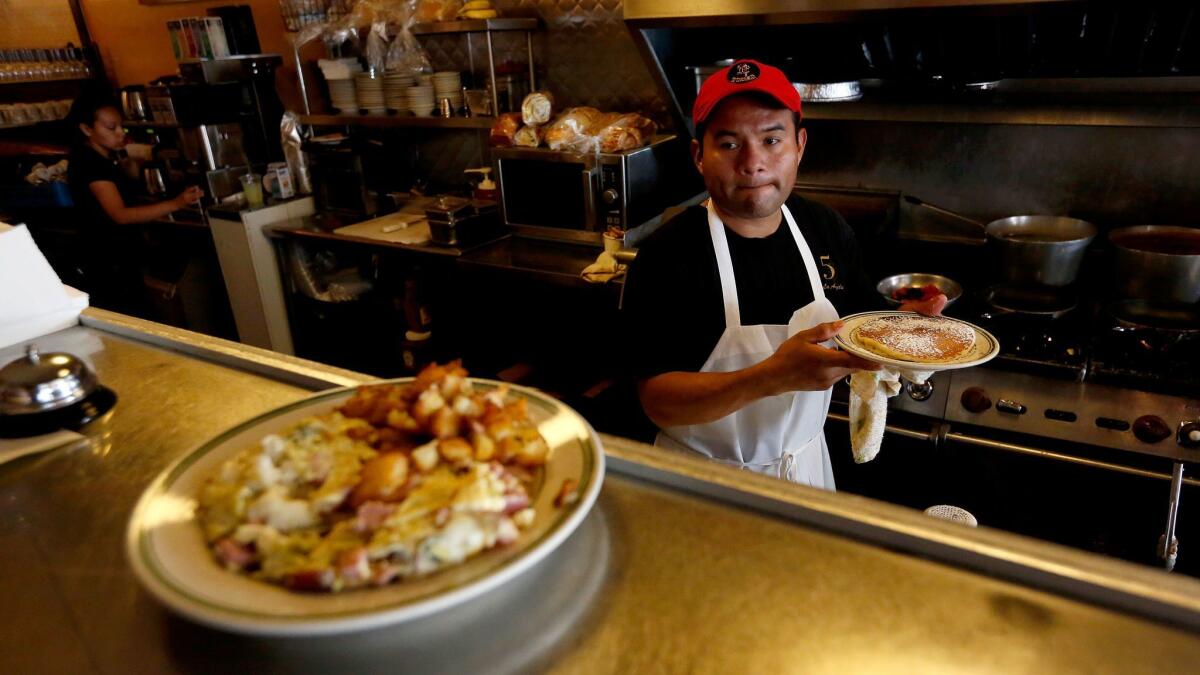Workers celebrate L.A.’s new $12 minimum wage, businesses brace for impact

- Share via
More than half a million Angelenos stand to get a raise this weekend, making the city the latest testing ground in the drive to boost incomes of bottom-rung workers.
Some businesses, facing a labor crunch, didn’t even wait for the new, $12 minimum wage to officially kick in.
Josh Loeb started doling out pay bumps among the 400 employees of his six mostly upscale restaurants about a month ago. He paid for it by inching up prices at those Santa Monica haunts, adding a dollar to an organic chicken, and 50 cents to a sandwich or salad.
“It’s got to come from somewhere,” said Loeb.
When the minimum wage in Los Angeles climbed from $10.50 to $12 an hour for large businesses on July 1, it marked the fourth such increase in three years, and the single largest year-over-year jump in the city’s scheduled climb to $15 for all employees by 2021.
The increase affects companies with 26 or more employees; smaller businesses follow suit in January. Santa Monica, Pasadena and unincorporated parts of Los Angeles County also went to $12 on Saturday. The state is also headed to $15, but on a slower schedule.
The city’s pay raise will add more than a billion dollars to local payrolls, according to estimates by the Economic Roundtable, a Los Angeles research group.
“It is a very important step toward these workers being able to afford to live in Los Angeles and to be able to afford the basic necessities for their families,” said Dan Flaming, the president of the Roundtable, who conducted the analysis.
But even before restaurant and other low-wage workers began protesting five years ago for higher pay — a movement that coalesced into the union-led Fight for $15 — economists were arguing about who benefits from raising the minimum wage, and at what cost. The latest round of debate was sparked Tuesday by a new study of jobs and pay in Seattle.
That research, published by the University of Washington, suggests that after Seattle went to a $13 floor, businesses cut hours and jobs for their lowest-paid workers, but higher-wage employment rose. Prior studies of minimum wage hikes elsewhere found little effect on hiring.
What happens in Los Angeles may be more relevant for urban America.
“It is a large metropolis, and it is closer to being a regular big city than Seattle and San Francisco, which everyone recognizes are unique in certain ways,” said Jeffrey Clemens, an economist at UC San Diego.
Half of the more than 566,000 people who were eligible for a raise in L.A. worked in restaurants and hotels, retail stores, healthcare and non-durable manufacturing — such as in apparel or food — according to the Economic Roundtable analysis of census data.
That count doesn’t include people who earn slightly more than the minimum wage, but will move up the ladder as the floor rises.
Anggie Godoy, 21, will see her pay increase from $10.60 to $12.10 Saturday. She’s been working at a McDonald’s in downtown Los Angeles for three and a half years, and occasionally chips in to help her mom and two siblings with bills.
Godoy is mainly working to support herself, to pay for community college tuition and car expenses.
“I’m just really happy to see it going up,” she said. “Any increase in what I take home means I get to worry a little less.” She’s applying to universities now, and said an increase in pay will help cover application fees.
“It’s one step closer to $15,” Godoy said.
Of course, businesses that spend most of their money on workers will try to find ways to cut costs. Loeb, the restaurateur, has already been trimming fat.
Cassia, one of the six establishments on the Westside that he co-owns, started serving lunch in the summer of 2016, right before the last minimum-wage hike. That foray ended after three months as Loeb realized the crowds were too thin and the tabs too small to cover his payroll. He had to lay off about 15 people.
Then, in the fall, Loeb changed the hours at Huckleberry, a more casual eatery, so that it closed at 5 p.m. rather than 8. Breakfast and lunch are the busiest times at the cafe, and dinner wasn’t delivering huge crowds.
“Labor is such a big consideration now that if you aren’t getting the most out of a service, it is very hard to justify it,” Loeb said.
Each time the wage rose since 2014, Loeb found a way to moderately increase his menu prices. That’s a privilege he can afford because his Santa Monica haunts attract a loyal clientele who generally won’t flinch at a gourmet price tag.
“Someone coming in and spending $200 for five people isn’t going to worry much about whether they are spending $209 now,” Loeb said.
Survey data collected by the University of Washington researchers suggested that restaurants in the city were choosing between two models: fine dining, where the money flows more freely, or cheap food served at a counter, so that few waiters or busboys are needed.
At risk, say restaurant owners, are restaurants that aim to serve sit-down meals that working-class people can afford.
Monica May, the chef and co-owner of the Nickel Diner near the edge of skid row in downtown Los Angeles, said a $12 minimum wage makes it hard to keep up the business.
“At my price point, I’m paralleling Denny’s,” said May, wiping her brow as she emerged from a hot kitchen on a recent Wednesday. The difference, May added, is that Denny’s customers don’t meet the chef. She then turned to give a regular a hug.
May and her business partner, general manager Kristen Trattner, employ fewer than 26 people, so they count as a small business and won’t have to pay $12 until 2018. But when that happens, Trattner said, they’ll face an existential crisis.
“Basically, our clock is ticking,” said Trattner.
The majority of the diner’s servers make more than the minimum wage. But when she has to hire new people at $12 an hour, it could make her longtime employees feel undervalued.
She knows she could start charging $13 for the cheeseburger with fries, which goes for $10.75 now. She could move to a fancier neighborhood, to pull in people who would see that price point as a steal.
But Trattner has no interest in going that way.
Right now, her customers include families that travel from neighborhoods in Watts or South Gate to get a home-cooked meal, police officers, public defenders and the occasional street-dweller.
“I like who I feed and as soon as I raise the prices, I change my clientele,” Trattner said.
At the table behind May sat a drifter who was making her way through a small mountain of Cobb salad with homemade blue cheese dressing.
“This is our revolution. At this price point we can turn people onto chef-driven and affordable food,” May said.
Adding pressure for restaurant owners, Los Angeles chose not to push wages up more slowly for businesses where workers get tips, as Seattle did.
A server at the Nickel can earn $30 extra per hour in tips on a typical weekend shift. At Loeb’s more upscale places, servers can rake in up to $50 an hour on top of their base wage during dinner.
Some restaurants feel they have to even the score for cooks, who don’t get gratuities.
Other businesses, however, see an upside in the higher wage rates.
Mark Rampolla, the CEO of the Los Angeles-based Beanfields Snacks, ran a paper packaging business in El Salvador for four years. He says his workers became more efficient and productive when he started handing out raises.
He is also counting on a trickle-down effect.
“We need people to have disposable income, and hopefully they will spend a little of that on chips and beverages or whatever we sell,” Rampolla said.
Rampolla admits, though, that the market for his products — gluten-free bean chips — gives him more breathing room.
“We are serving a higher-end consumer; think Whole Foods and Ralphs, not Walmart,” Rampolla said. “We definitely have a little bit of a luxury where others don’t.”
Staff writer Alexa D’Angelo contributed to this report.
Follow me @NatalieKitro on Twitter
ALSO
Editorial: What’s the right minimum wage? We still don’t have the answer
That new Seattle study is a big problem for fans of a higher minimum wage — or is it?
Los Angeles seeks $1.45 million from Carl’s Jr. for alleged minimum-wage violations
More to Read
Inside the business of entertainment
The Wide Shot brings you news, analysis and insights on everything from streaming wars to production — and what it all means for the future.
You may occasionally receive promotional content from the Los Angeles Times.











